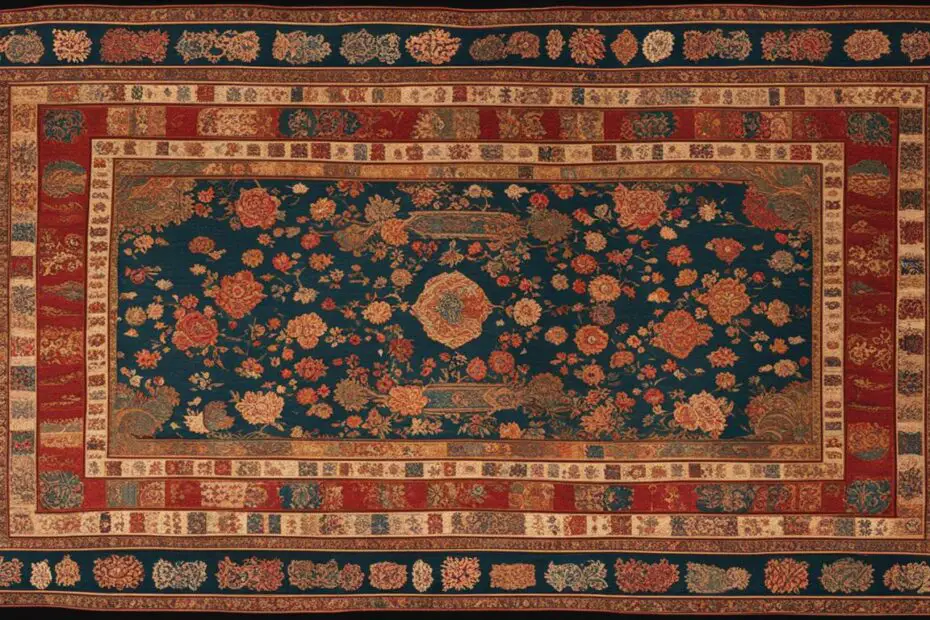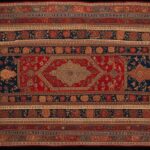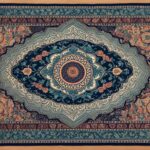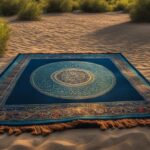When we think about prayer, we often envision a sacred space, a serene environment where we can connect with the divine. And at the heart of this spiritual experience lies the prayer mat. But have you ever wondered about the history behind this ancient tradition? Let’s delve into the fascinating world of prayer mats and unveil the deep-rooted prayer mat history.
Key Takeaways:
- Prayer mats, also known as prayer rugs, have a rich and diverse history that spans across civilizations.
- The origins of prayer mats can be traced back to ancient times and have been influenced by various cultural traditions and religious practices.
- These sacred objects hold immense cultural significance, symbolize the continuity of religious traditions, and reflect specific cultural symbols and artistic styles.
- In Islam, prayer mats play a vital role in creating a dedicated space for prayer, often incorporating geometric patterns and calligraphy from the Qur’an.
- Prayer mats have been showcased in historical mosques, featured in Islamic art, and are part of renowned art collections.
The Evolution of Prayer Mats
The history of prayer mats can be traced back to ancient civilizations, where worshippers would use simple mats or textiles to create a sacred space for prayer. These early prayer mats served a functional purpose, providing a clean and comfortable surface for individuals to kneel on during their devotional practices.
As societies developed and religious practices evolved, prayer mats began to incorporate decorative elements and symbolic motifs. These designs reflected the cultural traditions and beliefs of different communities, creating a deeper connection between worshippers and their spirituality.
Over time, prayer mats became more than just a practical item. They transformed into artistic expressions, showcasing the creativity and craftsmanship of various cultures. From intricate embroidery to vibrant patterns, prayer mats became a canvas for cultural storytelling and aesthetic beauty.
The materials used in prayer mats also evolved, influenced by the available resources and technological advancements of each era. Ancient prayer mats were often woven from natural fibers such as wool, silk, or cotton. As trade routes expanded, the introduction of new materials, dyes, and weaving techniques led to the production of prayer mats with more intricate patterns and colors.
In addition to the artistic and material evolution, prayer mats adapted to meet the needs and aesthetic preferences of worshippers. Different regions developed their own unique styles and designs, reflecting local traditions and customs. For example, in Persia (modern-day Iran), prayer mats became known for their elaborate geometric patterns, while in Turkey, prayer mats often featured floral motifs.
“The design philosophy behind ancient prayer mats was deeply connected to the spiritual and cultural identity of the worshippers,” explains Dr. Sarah Gonzalez, a renowned expert in Islamic art history. “These mats were not just tools for prayer but also visual representations of the individual’s spiritual journey and connection to a higher power.”
Today, prayer mats continue to be an integral part of religious practices and hold immense cultural significance. With each passing generation, these sacred objects carry forward the traditions, history, and spirituality of those who came before.
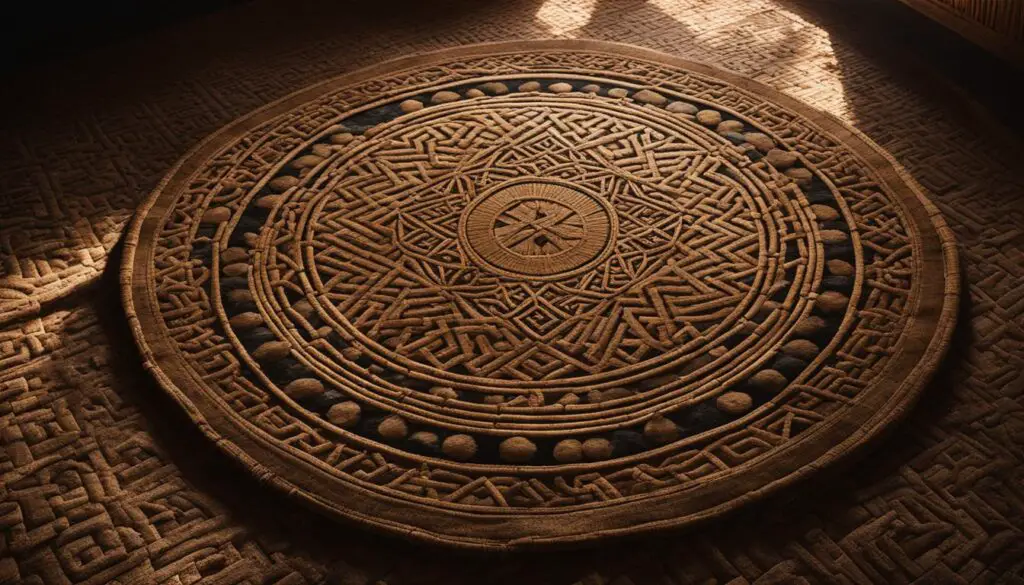
Example table showcasing the historical development of prayer mats:
| Time Period | Materials Used | Design and Motifs |
|---|---|---|
| Ancient civilizations | Natural fibers (wool, silk, cotton) | Simple patterns or plain |
| Medieval period | Wool, silk, cotton | Geometric patterns, calligraphy, and floral motifs |
| Golden Age of Islamic civilization | Wool, silk, gold threads | Elaborate geometric designs, intricate calligraphy |
| Modern era | Synthetic materials, such as acrylic | Blend of traditional and contemporary designs |
Cultural Significance of Prayer Mats
Prayer mats hold immense cultural significance in many societies. They are not just ordinary objects used for prayer; they represent a powerful connection between individuals and their religious traditions. These traditional prayer mats are considered sacred and are used to create a sense of reverence during prayer.
In some cultures, prayer mats are treasured heirlooms that are passed down through generations, symbolizing the continuity of religious practices. They carry the weight of history and serve as a tangible link between individuals and their ancestors. These prayer mats become more than just pieces of fabric; they embody the cultural heritage and spiritual devotion of the people.
The design and motifs on prayer mats also play a significant role in highlighting their cultural significance. The patterns and symbols woven or embroidered onto these mats often represent specific cultural symbols, traditions, or artistic styles. Each intricate detail tells a story or reflects a unique cultural identity, reinforcing the deep-rooted connection between prayer mats and the cultures they come from.

Prayer mats serve as tangible expressions of faith and cultural identity, reminding worshippers of their heritage and instilling a sense of comfort and belonging.
Furthermore, prayer mats transcend religious boundaries and become a way to honor and celebrate diversity. They showcase the artistic traditions of different cultures, featuring a wide range of colors, patterns, and materials. Whether it’s the intricate geometric designs found in Islamic prayer mats or the vibrant tapestries used by Native American communities, each prayer mat exemplifies the unique cultural heritage it represents.
Through their craftsmanship and symbolism, prayer mats become a visual representation of the shared human experience and the universal pursuit of spirituality. They serve as a bridge between generations, cultures, and religions, fostering understanding, respect, and a sense of unity.
The Use of Prayer Mats in Islam
In Islam, prayer mats hold a special place in religious practices. Muslim worshippers use prayer mats as a clean and designated space for prayer, creating a symbolic separation from the secular world. Prayer mats are often placed facing Mecca, the holiest city in Islam, during prayers. They serve as a physical reminder of the importance of prayer and the connection between the individual and the divine. The design and motifs on Islamic prayer mats often incorporate geometric patterns or calligraphy from the Qur’an, reflecting the artistic traditions of the Islamic world.
Cultural Significance of Prayer Mats in Islam
The cultural significance of prayer mats in Islam goes beyond their functional use. These mats are seen as sacred objects and are treated with great respect and care. The act of unfolding and setting up a prayer mat is considered a ritual in itself, signifying the transition into a sacred space for prayer.
“When a Muslim stands on a prayer mat facing Mecca, they are entering a state of focused devotion and surrender. The prayer mat becomes a symbolic bridge between the worshipper and their creator, a physical representation of the spiritual connection.”
The design of Islamic prayer mats is often intricate and exquisite, with elaborate patterns and symbols. These designs vary from region to region, reflecting the diverse cultural heritage of the Muslim world. Geometric patterns are commonly featured on prayer mats, representing the harmony and order found in nature and the universe. Calligraphy from the Qur’an, the holy book of Islam, is also frequently incorporated into the design, emphasizing the reverence for the sacred text.
Islamic prayer mats are not only functional but also serve as a form of personal expression and reflection. Each mat holds the individual’s devotion, prayers, and spiritual journey. Through the act of prayer on a designated mat, worshippers feel a sense of unity with the global Muslim community, as they share a common practice and symbol of faith.

As prayer mats continue to be used in mosques and homes worldwide, they remain an important cultural symbol for Muslims. These mats bear witness to the faith, devotion, and connection between the individual and the divine.
The cultural significance of prayer mats in Islam can be further understood through the following table:
| Prayer Mat Significance | Description |
|---|---|
| Ritual Symbolism | The act of setting up the prayer mat is a ritual, signifying the transition into a sacred space for prayer. |
| Unity and Communal Bond | Through the use of prayer mats, Muslims feel connected to the global Muslim community and their shared practice of faith. |
| Symbol of Devotion | Each prayer mat holds the individual’s personal devotion, prayers, and spiritual journey. |
| Artistic Expression | The intricate designs and calligraphy on prayer mats reflect the diverse cultural heritage and artistic traditions of the Islamic world. |
Prayer Mats in Historical Mosques
Throughout history, historical mosques around the world have showcased the beauty and craftsmanship of prayer mats, providing a glimpse into the rich cultural and religious traditions associated with these sacred spaces. These mosques have dedicated prayer areas adorned with intricately woven or embroidered prayer mats, exemplifying the historical background and traditional significance of these sacred objects.
One such mosque that highlights the historical development of prayer mats is Masjid-e-Nabawi in Saudi Arabia. This magnificent mosque, also known as the Prophet’s Mosque, is one of the oldest and most revered mosques in the world. It houses a vast prayer area adorned with prayer mats that reflect the cultural and artistic traditions of the time.
The prayer mats found in historical mosques were meticulously crafted with attention to detail and craftsmanship. They often feature intricate designs, geometric patterns, and symbolic motifs that hold cultural and religious significance. These traditional prayer mats served as a visual representation of the devotion and reverence of worshippers, creating a sacred space for prayer and reflection.
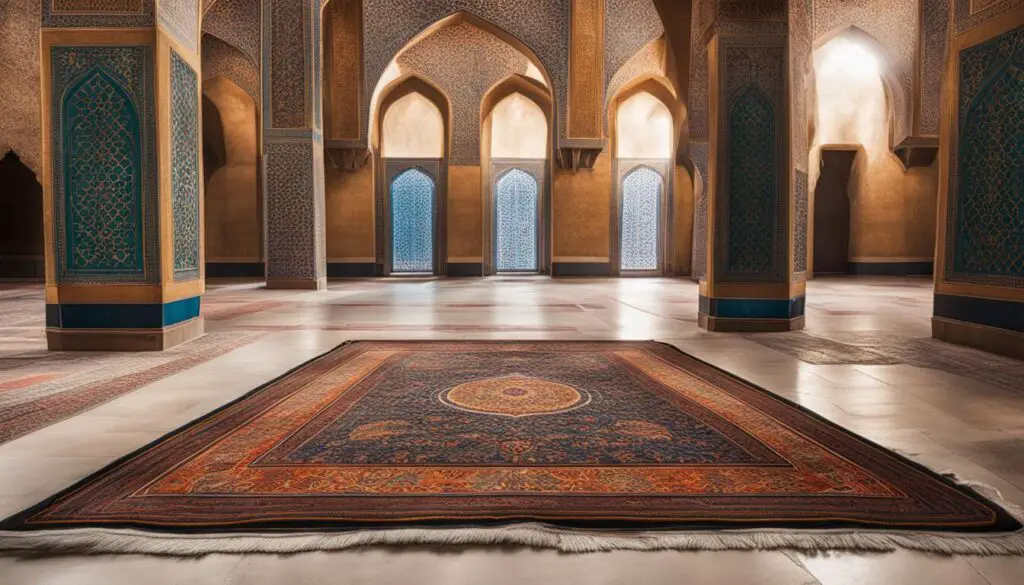
Beautifully Crafted Prayer Mats
The prayer mats found in historical mosques were not only functional but also pieces of art. Skilled artisans dedicated their time and expertise to create these beautifully crafted prayer mats, using traditional techniques that have been passed down through generations. The materials used varied depending on the region and cultural traditions, ranging from woven textiles to luxurious silk and velvet. The design motifs often featured intricate floral patterns, calligraphy, and geometric shapes, reflecting the artistic styles prevalent during the respective time periods.
“Historical mosques preserve the beauty and craftsmanship of prayer mats, showcasing the cultural and spiritual significance associated with these sacred objects.”
These prayer mats not only added aesthetic beauty to the prayer areas but also enhanced the spiritual experience for worshippers. Striking the perfect balance between functionality and artistic expression, traditional prayer mats in historical mosques served as a physical reminder of the sacredness of prayer and the connection between the individual and their faith.
Preserving Cultural Heritage
The preservation and display of prayer mats in historical mosques play a crucial role in honoring and preserving cultural heritage. They serve as tangible artifacts that offer insights into the historical and artistic aspects of prayer mat traditions across different regions and time periods. By showcasing these prayer mats, historical mosques contribute to the understanding and appreciation of the cultural, religious, and artistic diversity that exists within the Islamic world.
These prayer mats not only serve as symbols of cultural heritage but also inspire worshippers by connecting them to the rich history of their faith. The intricate designs and craftsmanship of these traditional prayer mats captivate visitors and offer a glimpse into the devotion and spirituality associated with prayer. They also foster a sense of unity among worshippers, transcending geographical boundaries and emphasizing the universal nature of spirituality.
High-Tech Prayer Mats in Modern Mosques
In recent times, prayer mats have embraced modern technology to cater to the needs of worshippers in the digital age. One notable example is the introduction of high-tech prayer mats embedded with RFID chips at the renowned Masjid-e-Nabawi in Saudi Arabia.
These innovative prayer mats are equipped with a radio-frequency identification (RFID) system that revolutionizes the process of identifying which mats require cleaning. The RFID chips embedded in the mats enable mosque authorities to automate the monitoring and maintenance of the prayer mats, ensuring cleanliness and hygiene.
When a worshipper places the high-tech prayer mat in a designated area after use, the RFID system detects its presence. This smart technology eliminates the need for manual inspection, allowing the mosque authorities to quickly identify and separate soiled mats for cleaning. The RFID chips also facilitate effective maintenance schedules, ensuring that each prayer mat is washed regularly.
By incorporating modern technology into prayer mats, mosques can streamline their operations and provide a convenient and efficient prayer experience for worshippers. The introduction of high-tech prayer mats not only demonstrates the continued development and technological advancement in the prayer mat history but also exemplifies the adaptability of religious practices to the modern world.
“The introduction of high-tech prayer mats in modern mosques represents a significant milestone in the historical development of prayer mats. This integration of technology enhances the overall experience for worshippers, ensuring cleanliness, and efficiency.” – Imam Ahmed Malik
Through the integration of RFID technology, prayer mats have embraced the digital era while preserving their cultural and spiritual significance. Worshippers in modern mosques can enjoy the convenience of high-tech prayer mats, while still engaging in the timeless act of prayer.

| Benefits of High-Tech Prayer Mats | Challenges |
|---|---|
|
|
The Grand Mosque in Makkah and Its Prayer Mats
The Grand Mosque in Makkah, Saudi Arabia, holds a special place as one of the most significant and sacred sites in Islam. It serves as the focal point for millions of Muslims around the world, who gather here to perform the holy pilgrimage of Hajj and Umrah. Within the mosque, a vast prayer area awaits worshippers, adorned with traditional prayer mats that carry both cultural and historical significance.
The prayer mats used in the Grand Mosque are meticulously crafted from 100% pure acrylic yarn. This careful choice of material ensures not only durability but also a sense of comfort for the worshippers. The mats are designed to be both soft and resilient, providing a clean and comfortable space for individuals to engage in their daily prayers.
Regular cleaning and maintenance are undertaken to keep the prayer mats in pristine condition. This attention to detail ensures that worshippers are presented with a hygienic and welcoming environment as they connect with their spirituality. The cleanliness and state of the prayer mats further enhance the overall experience within the mosque, creating an atmosphere of tranquility and devotion.
The prayer mats in the Grand Mosque represent a visual representation of the cultural heritage and historical background of prayer mats. They are a tangible symbol of the religious traditions that have been passed down through generations. These mats not only provide a physical space for prayer but also hold a deep spiritual significance for the worshippers who tread upon them.
As visitors to the Grand Mosque kneel and prostrate on these traditional prayer mats, they become part of a long-standing tradition that transcends time and connects them to the rich cultural tapestry of Islam. Each mat silently narrates stories of faith, devotion, and unity, making the prayer experience in the Grand Mosque truly awe-inspiring.
Prayer Mats in the Grand Mosque – Key Features:
| Material | Design | Comfort |
|---|---|---|
| Pure acrylic yarn | Traditional motifs | Soft and resilient |
| Durable | Cultural significance | Hygienic and welcoming |
Prayer Mats in Global Islamic Art
Prayer mats have played a significant role not only in religious practices but also in the realm of Islamic art. Throughout history, prayer mats have been prominently featured in various forms of visual representation, showcasing their cultural and religious significance.
One such example is the inclusion of prayer mats in illuminated manuscripts. These beautifully crafted manuscripts depict worshippers on prayer mats, capturing the essence and devotion of prayer in intricate detail. The use of vibrant colors and delicate brushwork brings the scenes to life, immersing viewers in the spiritual experience.
“The prayer mat is a symbol of devotion and serves as a visual representation of the relationship between the individual and the divine,” explains art historian Aisha Rahman.
“The inclusion of prayer mats in Islamic art not only showcases the importance of prayer within the religion but also highlights the artistic expression and creativity of different cultures and time periods.”
In addition to illuminated manuscripts, prayer mats have also inspired breathtaking paintings that capture the beauty of prayer spaces. Artists have depicted the intricate designs and patterns found in prayer mats, showcasing their artistic skills while paying homage to the deep-rooted traditions of prayer.
An exemplary painting by renowned artist Yusuf Abdullah depicts a serene mosque interior adorned with prayer mats. The meticulous attention to detail in the depiction of the mats’ motifs and colors reflects the rich cultural heritage and historical significance of prayer mats in Islamic art. This painting stands as a testament to the enduring beauty and spiritual significance of prayer mats in global Islamic art.
Prayer mats, through their presence in Islamic art, serve as a visual reminder of the importance of prayer and the deep-rooted cultural roots of this sacred practice. They represent the connection between the individual and the divine, inviting viewers to contemplate the power of faith and devotion.
| Key Points | Impact |
|---|---|
| Prayer mats in illuminated manuscripts | Highlights the devotion and spiritual significance of prayer |
| Inspiring paintings of prayer spaces | Captures the beauty of prayer mats and their cultural symbolism |
| Symbolic connection between the individual and the divine | Invites viewers to contemplate the power of faith and devotion |
The Metropolitan Museum of Art’s Islamic Art Collection
The Metropolitan Museum of Art in New York proudly displays an extensive collection of Islamic art, embodying the cultural richness and diversity of prayer mats. This remarkable collection represents prayer mats from various regions, spanning different time periods and artistic styles.
The museum has undertaken a comprehensive reinstallation and enlargement project of its Islamic art collection, aiming to deepen the understanding and appreciation of the fascinating history of prayer mats. This initiative serves as a pivotal step in raising awareness about the visual culture of the Islamic world in America.
The Diplomatic and Curatorial Challenges of the Project
The reinstallation project of the Metropolitan Museum of Art’s Islamic Art Collection has encountered various diplomatic and curatorial challenges. To ensure an accurate and sensitive representation of Islamic art, the museum has collaborated closely with Islamic-art scholars and engaged with countries whose regions are featured in the collection. This endeavor has required navigating cultural and political sensitivities, aiming for a respectful and inclusive portrayal of Islamic art.
The project presented a particular concern regarding the display of artworks depicting the Prophet Muhammad. The museum addressed this issue with great care, adopting an approach that seeks to foster understanding and appreciation while maintaining cultural sensitivity.
“The challenge of displaying art that depicts the Prophet Muhammad lies in finding the delicate balance between honoring the artistic value and cultural significance of these works while respecting the religious sensitivities surrounding their portrayal.” – Curator of Islamic Art, Metropolitan Museum of Art
The Metropolitan Museum of Art’s commitment to diplomacy and meticulous curation has been instrumental in navigating the complexities of this project. By engaging in respectful dialogue and collaboration with experts and communities, the museum aims to present a comprehensive and culturally sensitive representation of the history and development of prayer mats.
Through this reinstallation, the Metropolitan Museum of Art continues to fulfill its mission of promoting cross-cultural understanding and appreciation of Islamic art and its profound connection to prayer mat history.
| Challenges | Approach |
|---|---|
| Cultural and political sensitivities | – Collaborative efforts with scholars and countries represented in the collection – Empathy and understanding of diverse perspectives |
| Displaying art depicting the Prophet Muhammad | – Cultural sensitivity and careful curation – Maintaining a respectful and inclusive environment |
Conclusion
The history of prayer mats is an illuminating testament to their deep-rooted cultural and spiritual significance across civilizations. These sacred objects have witnessed the passage of time, from their ancient origins to the modern era of high-tech adaptations. Throughout history, prayer mats have been integral to religious traditions worldwide, serving as a physical and symbolic connection between individuals and their faith.
The reinstallation of the Metropolitan Museum of Art’s Islamic Art Collection offers a captivating insight into the rich history and cultural significance of prayer mats. By showcasing a diverse range of prayer mats from different regions and time periods, the museum fosters an understanding and appreciation for the visual culture of the Islamic world.
These artifacts carry the weight of ancient traditions and beliefs, representing the artistic, technological, and spiritual evolution of prayer mats. Through their intricate designs, motifs, and materials, prayer mats encapsulate the vibrant tapestry of cultural heritage and artistic expression.
By exploring the prayer mat history, we gain a deeper understanding of the customs, traditions, and values that have shaped societies throughout the ages. Through the lens of prayer mats, we are invited to embrace cultural diversity, engage in dialogue, and cultivate a greater appreciation for the rich tapestry of human spirituality.
FAQ
What is the history of prayer mats?
Prayer mats have a long and rich history that dates back to ancient civilizations. They have evolved over time, incorporating decorative elements and symbolic motifs from various cultural traditions.
Why are prayer mats culturally significant?
Prayer mats hold immense cultural significance in many societies. They are considered sacred objects and often passed down through generations as heirlooms, symbolizing the continuity of religious traditions and the connection between individuals and their ancestors.
How are prayer mats used in Islam?
In Islam, prayer mats are used as a clean and designated space for prayer. They create a symbolic separation from the secular world and serve as a physical reminder of the importance of prayer and the connection between the individual and the divine.
How are prayer mats represented in historical mosques?
Historical mosques often have specially designed prayer areas adorned with intricately woven or embroidered prayer mats. These mats showcase the beauty and craftsmanship of prayer mats throughout the centuries.
What is the significance of prayer mats in Islamic art?
Prayer mats have been featured in Islamic art throughout history, from illuminated manuscripts to intricate paintings. They serve as a prominent subject in the visual representation of Islamic traditions and exemplify their cultural and religious significance.
What can be seen in the Metropolitan Museum of Art’s Islamic Art Collection?
The Metropolitan Museum of Art in New York showcases an extensive collection of Islamic art, including prayer mats. The collection represents a diverse range of mats from different regions, time periods, and artistic styles.
What were the challenges faced during the reinstallation of the Metropolitan Museum’s Islamic Art Collection?
The reinstallation project faced curatorial and diplomatic challenges. The museum worked closely with Islamic art scholars and navigated cultural and political sensitivities to ensure a respectful and inclusive representation of Islamic art.
What is the cultural and spiritual significance of prayer mats?
The history of prayer mats is a testament to their deep-rooted cultural and spiritual significance across civilizations. They have played a crucial role in religious traditions and continue to evolve to meet the needs of worshippers in the modern world.
Source Links
- https://www.denverpost.com/2005/12/24/prayer-a-history-by-philip-zaleski-and-carol-zaleski/
- https://www.nytimes.com/2011/09/25/arts/design/islamic-art-treasures-at-the-metropolitan-museum.html
- https://tribune.com.pk/story/2409682/the-amazing-features-of-the-hi-tech-prayer-mats-at-the-two-holy-mosques


